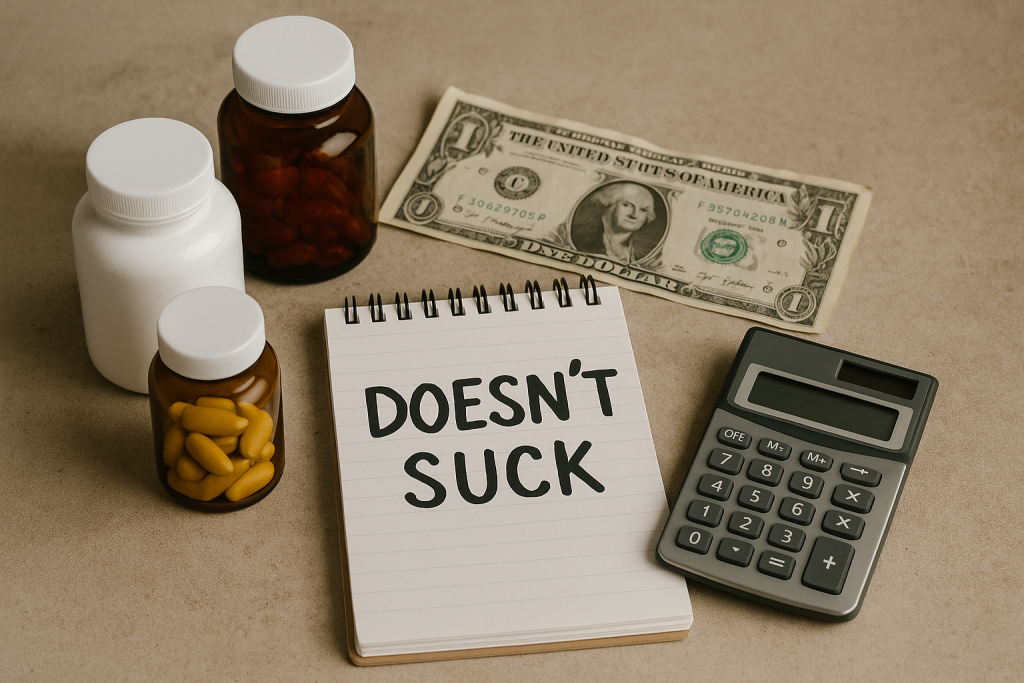Note: This post may contain affiliate links. If you click and buy, I may earn a small commission at no cost to you. I only recommend what I use and trust.
You’re broke, tired, and trying to fix your health. But supplements are expensive—and most of them are trash.
Here’s how to build a budget supplement stack that actually does something. This isn’t a list of random cheap pills. This is how to think, how to pick, and how to stretch your budget without ending up with a cabinet full of powdered disappointment.
1. Know What You’re Solving For
Don’t go buying supplements just because someone on YouTube said they’re “good for you.”
Start with a single goal:
- Low energy?
- Brain fog?
- High blood pressure?
- Poor sleep?
- Always sick?
You don’t need 12 bottles. You need 2 or 3 that directly hit the problem. Everything else can wait.If you can’t name the problem, you don’t need a stack—you need bloodwork, a journal, or a better doctor.
2. Tier Your Stack: Core vs. Extras
A budget stack isn’t built on hype—it’s built on essentials.
Core Supplements (Low Cost, High Impact):
These are cheap and cover a lot of ground:
- Magnesium (glycinate or malate): for sleep, blood pressure, muscle support
- CoQ10 (ubiquinone is fine): for fatigue, heart support
- A real multivitamin (not Centrum garbage): to plug basic gaps
- Taurine: dirt cheap and supports blood pressure, hydration, and heart rhythm
Extras (Optional, Conditional, or Pricey):
Use only if your goal calls for it and you can afford it:
- Turkey Tail or Reishi: for immune support
- L-citrulline: for circulation and stamina
- ALCAR or ALA: for nerve support
- NAC: for lungs, liver, and oxidative stress
Start with core picks. Add extras if your budget and your problem demand it.
3. Stretch Every Dollar (Without Getting Scammed)
Here’s how to keep your wallet alive:
- Use powders when possible (like citrulline or taurine)—but only if you’re okay with taste and measuring
- Buy from legit brands that don’t fluff their labels. Look for 3rd-party tested or ones you trust
- Check cost per dose, not just bottle price. That $12 bottle might be a 5-day supply
- Take breaks—you don’t always need to take everything daily
- Don’t pay for “blends.” They hide garbage behind fancy names
Price doesn’t equal quality. But ultra-cheap usually equals garbage.
4. Budget Stack Examples (Pick Based on Goal)
Energy + Focus (Budget Build)
- B-complex (with methylated forms)
- CoQ10 – 100 mg (ubiquinone is fine)
- Magnesium (malate or glycinate)
Blood Pressure Support (Budget Build)
- Taurine – 1,000–2,000 mg daily
- Olive Leaf Extract – 500–750 mg (20% oleuropein)
- Magnesium (again—it matters)
Immune Support (Budget Build)
- Vitamin D3 – 2,000 IU daily
- Zinc (not more than 15–25 mg unless deficient)
- Turkey Tail – 600 mg
- (Optional: NAC if lungs/liver are an issue)
You don’t need to copy these exactly. They’re templates. Adjust for your situation, not someone else’s problems.
5. What to Avoid (to Keep Your Wallet and Liver Alive)
- ❌ “Proprietary blends” — These are how companies hide underdosed junk
- ❌ “Detox” powders and greens drinks — They’re overpriced flavored fiber
- ❌ Centrum, One A Day, and store-brand multis — Low-quality forms, pixie dust minerals
- ❌ Overhyped influencer pills — Usually overpriced, underdosed, or both
If it looks like a $60 miracle cure and it’s sold by someone with perfect abs and zero science? Walk away.
Final Word
A good stack doesn’t have to cost $200 a month.
But a trash stack is still expensive—even if it’s cheap.
Figure out what you actually need. Start with proven, budget-friendly supplements. Skip the fluff. Build up over time.
No magic. Just what works.
